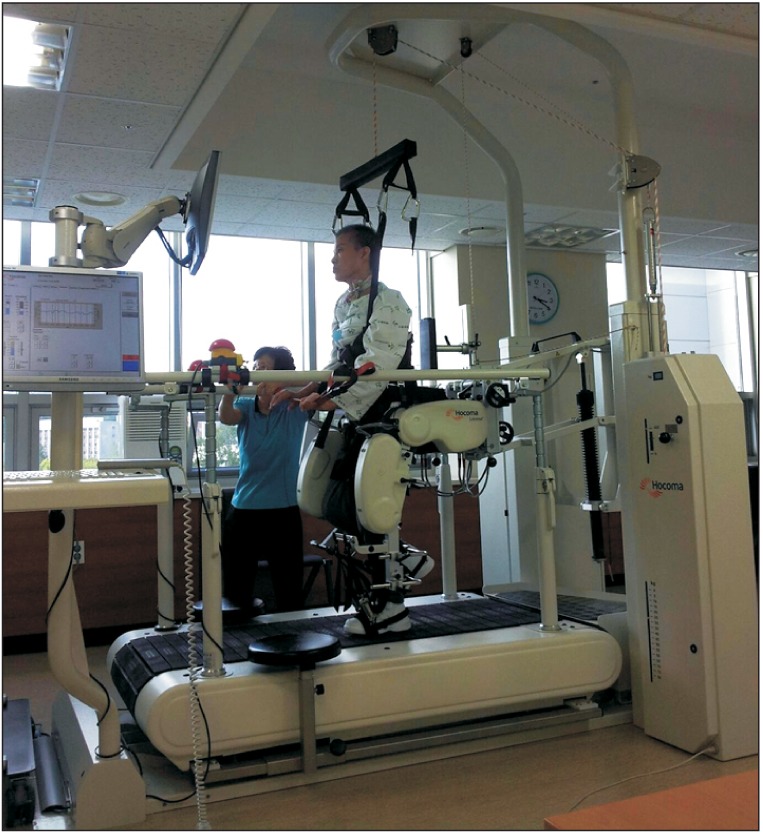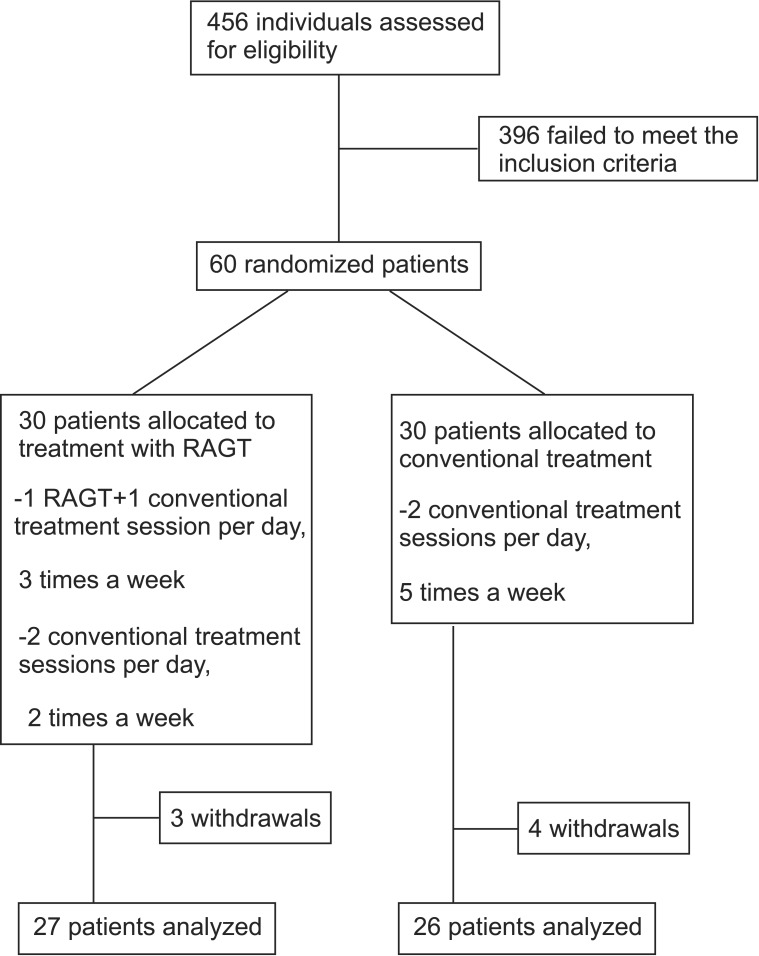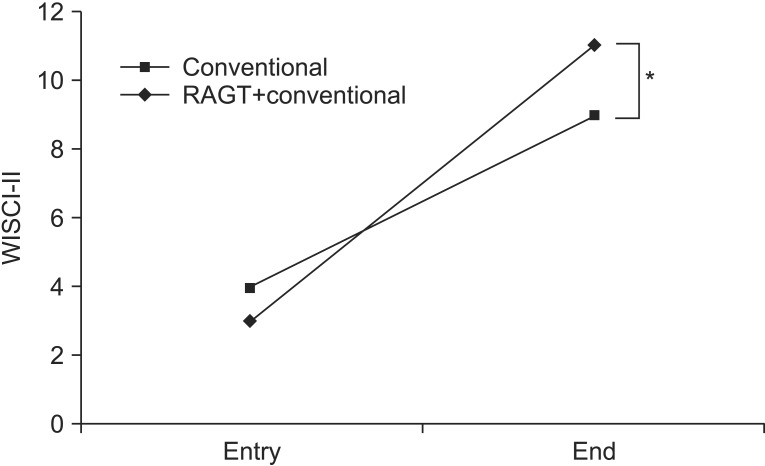Ann Rehabil Med.
2014 Dec;38(6):719-725. 10.5535/arm.2014.38.6.719.
Effect of Robotic-Assisted Gait Training in Patients With Incomplete Spinal Cord Injury
- Affiliations
-
- 1Department of Rehabilitation Medicine and Research Institute of Rehabilitation Medicine, Yonsei University College of Medicine, Seoul, Korea. kny8452@hanmail.net
- KMID: 2267080
- DOI: http://doi.org/10.5535/arm.2014.38.6.719
Abstract
OBJECTIVE
To determine the effect of robotic-assisted gait training (RAGT) compared to conventional overground training.
METHODS
Sixty patients with motor incomplete spinal cord injury (SCI) were included in a prospective, randomized clinical trial by comparing RAGT to conventional overground training. The RAGT group received RAGT three sessions per week at duration of 40 minutes with regular physiotherapy in 4 weeks. The conventional group underwent regular physiotherapy twice a day, 5 times a week. Main outcomes were lower extremity motor score of American Spinal Injury Association impairment scale (LEMS), ambulatory motor index (AMI), Spinal Cord Independence Measure III mobility section (SCIM3-M), and walking index for spinal cord injury version II (WISCI-II) scale.
RESULTS
At the end of rehabilitation, both groups showed significant improvement in LEMS, AMI, SCIM3-M, and WISCI-II. Based on WISCI-II, statistically significant improvement was observed in the RAGT group. For the remaining variables, no difference was found.
CONCLUSION
RAGT combined with conventional physiotherapy could yield more improvement in ambulatory function than conventional therapy alone. RAGT should be considered as one additional tool to provide neuromuscular reeducation in patient with incomplete SCI.
MeSH Terms
Figure
Cited by 2 articles
-
Improved Gait Speed After Robot-Assisted Gait Training in Patients With Motor Incomplete Spinal Cord Injury: A Preliminary Study
Seungwon Hwang, Hye-Ri Kim, Zee-A Han, Bum-Suk Lee, Soojeong Kim, Hyunsoo Shin, Jae-Gun Moon, Sung-Phil Yang, Mun-Hee Lim, Duk-Youn Cho, Hayeon Kim, Hye-Jin Lee
Ann Rehabil Med. 2017;41(1):34-41. doi: 10.5535/arm.2017.41.1.34.Robot-Assisted Gait Training in Individuals With Spinal Cord Injury: A Systematic Review and Meta-Analysis of Randomized Controlled Trials
Jong Mi Park, Yong Wook Kim, Su Ji Lee, Ji Cheol Shin
Ann Rehabil Med. 2024;48(3):171-191. doi: 10.5535/arm.230039.
Reference
-
1. van Middendorp JJ, Hosman AJ, Van de Meent H. Who wants to walk? Preferences for recovery after SCI: a longitudinal and cross-sectional study. Spinal Cord. 2009; 47:268–269. PMID: 18936769.
Article2. Shin JC, Kim DH, Yu SJ, Yang HE, Yoon SY. Epidemiologic change of patients with spinal cord injury. Ann Rehabil Med. 2013; 37:50–56. PMID: 23525183.
Article3. Burns SP, Golding DG, Rolle WA Jr, Graziani V, Ditunno JF Jr. Recovery of ambulation in motor-incomplete tetraplegia. Arch Phys Med Rehabil. 1997; 78:1169–1172. PMID: 9365343.
Article4. van Middendorp JJ, Hosman AJ, Pouw MH. EM-SCI Study Group. Van de Meent H. ASIA impairment scale conversion in traumatic SCI: is it related with the ability to walk? A descriptive comparison with functional ambulation outcome measures in 273 patients. Spinal Cord. 2009; 47:555–560. PMID: 19104512.
Article5. Dietz V, Colombo G, Jensen L, Baumgartner L. Locomotor capacity of spinal cord in paraplegic patients. Ann Neurol. 1995; 37:574–582. PMID: 7755351.
Article6. AuYong N, Lu DC. Neuromodulation of the lumbar spinal locomotor circuit. Neurosurg Clin N Am. 2014; 25:15–23. PMID: 24262896.
Article7. Alcobendas-Maestro M, Esclarin-Ruz A, Casado-Lopez RM, Munoz-Gonzalez A, Perez-Mateos G, Gonzalez-Valdizan E, et al. Lokomat robotic-assisted versus overground training within 3 to 6 months of incomplete spinal cord lesion: randomized controlled trial. Neurorehabil Neural Repair. 2012; 26:1058–1063. PMID: 22699827.8. Schwartz I, Sajina A, Neeb M, Fisher I, Katz-Luerer M, Meiner Z. Locomotor training using a robotic device in patients with subacute spinal cord injury. Spinal Cord. 2011; 49:1062–1067. PMID: 21625239.
Article9. Field-Fote EC, Roach KE. Influence of a locomotor training approach on walking speed and distance in people with chronic spinal cord injury: a randomized clinical trial. Phys Ther. 2011; 91:48–60. PMID: 21051593.
Article10. Mehrholz J, Kugler J, Pohl M. Locomotor training for walking after spinal cord injury. Cochrane Database Syst Rev. 2012; 11:CD006676. PMID: 23152239.
Article11. Swinnen E, Duerinck S, Baeyens JP, Meeusen R, Kerckhofs E. Effectiveness of robot-assisted gait training in persons with spinal cord injury: a systematic review. J Rehabil Med. 2010; 42:520–526. PMID: 20549155.
Article12. Morawietz C, Moffat F. Effects of locomotor training after incomplete spinal cord injury: a systematic review. Arch Phys Med Rehabil. 2013; 94:2297–2308. PMID: 23850614.
Article13. Lennon S, Baxter D, Ashburn A. Physiotherapy based on the Bobath concept in stroke rehabilitation: a survey within the UK. Disabil Rehabil. 2001; 23:254–262. PMID: 11336098.14. Mirbagheri MM, Kindig M, Niu X, Varoqui D, Conaway P. Robotic-locomotor training as a tool to reduce neuromuscular abnormality in spinal cord injury: the application of system identification and advanced longitudinal modeling. IEEE Int Conf Rehabil Robot. 2013; 2013:6650497. PMID: 24187312.
Article15. Knikou M, Mummidisetty CK. Locomotor training improves premotoneuronal control after chronic spinal cord injury. J Neurophysiol. 2014; 111:2264–2275. PMID: 24598526.
Article16. Fritz SL, Merlo-Rains AM, Rivers ED, Peters DM, Goodman A, Watson ET, et al. An intensive intervention for improving gait, balance, and mobility in individuals with chronic incomplete spinal cord injury: a pilot study of activity tolerance and benefits. Arch Phys Med Rehabil. 2011; 92:1776–1784. PMID: 21831355.
Article17. Varoqui D, Niu X, Mirbagheri MM. Ankle voluntary movement enhancement following robotic-assisted locomotor training in spinal cord injury. J Neuroeng Rehabil. 2014; 11:46. PMID: 24684813.
Article18. Wirz M, Zemon DH, Rupp R, Scheel A, Colombo G, Dietz V, et al. Effectiveness of automated locomotor training in patients with chronic incomplete spinal cord injury: a multicenter trial. Arch Phys Med Rehabil. 2005; 86:672–680. PMID: 15827916.
Article19. Mirbagheri MM, Niu X, Kindig M, Varoqui D. The effects of locomotor training with a robotic-gait orthosis (Lokomat) on neuromuscular properties in persons with chronic SCI. Conf Proc IEEE Eng Med Biol Soc. 2012; 2012:3854–3857. PMID: 23366769.
Article20. Labruyere R, van Hedel HJ. Strength training versus robot-assisted gait training after incomplete spinal cord injury: a randomized pilot study in patients depending on walking assistance. J Neuroeng Rehabil. 2014; 11:4. PMID: 24401143.21. Lam T, Pauhl K, Krassioukov A, Eng JJ. Using robot-applied resistance to augment body-weight-supported treadmill training in an individual with incomplete spinal cord injury. Phys Ther. 2011; 91:143–151. PMID: 21127165.
Article22. Dobkin B, Apple D, Barbeau H, Basso M, Behrman A, Deforge D, et al. Weight-supported treadmill vs over-ground training for walking after acute incomplete SCI. Neurology. 2006; 66:484–493. PMID: 16505299.
Article23. Benito-Penalva J, Edwards DJ, Opisso E, Cortes M, Lopez-Blazquez R, Murillo N, et al. Gait training in human spinal cord injury using electromechanical systems: effect of device type and patient characteristics. Arch Phys Med Rehabil. 2012; 93:404–412. PMID: 22209475.
Article24. Semerjian TZ, Montague SM, Dominguez JF, Davidian AM, de Leon RD. Enhancement of quality of life and body satisfaction through the use of adapted exercise devices for individuals with spinal cord injuries. Top Spinal Cord Inj Rehabil. 2005; 11:95–108.
Article25. Martin Ginis KA, Latimer AE. The effects of single bouts of body-weight supported treadmill training on the feeling states of people with spinal cord injury. Spinal Cord. 2007; 45:112–115. PMID: 16520818.
Article26. Hicks AL, Adams MM, Martin Ginis K, Giangregorio L, Latimer A, Phillips SM, et al. Long-term body-weight-supported treadmill training and subsequent follow-up in persons with chronic SCI: effects on functional walking ability and measures of subjective well-being. Spinal Cord. 2005; 43:291–298. PMID: 15685260.
Article
- Full Text Links
- Actions
-
Cited
- CITED
-
- Close
- Share
- Similar articles
-
- Improved Gait Speed After Robot-Assisted Gait Training in Patients With Motor Incomplete Spinal Cord Injury: A Preliminary Study
- Use of robots in rehabilitative treatment
- Robot-assisted Therapy in Stroke Rehabilitation
- A Review of Robot-Assisted Gait Training in Stroke Patients
- Effects of Robot-assisted Gait Therapy on Locomotor Recovery in Stroke Patients




